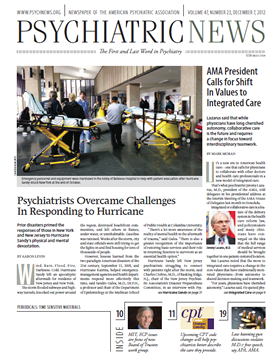There are a number of real and potential benefits to patients, physicians, and third-party payers from systematic specification of services rendered by physicians (including psychiatrists) in direct patient care. The AMA first developed and published Current Procedural Terminology (CPT) in 1966. This manual helped encourage the use of standard terms and descriptors to document procedures in the medical record, helped communicate accurate information on procedures and services to agencies concerned with insurance claims, and contributed basic information for actuarial and statistical purposes.
This first edition of CPT contained primarily surgical procedures. The second edition, published in 1970, included an expanded system of terms and codes to designate diagnostic and therapeutic procedures in medicine, surgery, and the specialties. It introduced a five-digit coding system, replacing the four-digit classification. In the mid to late 1970s, the third and fourth editions of CPT were published. In 1983 CPT was adopted by the Centers for Medicare and Medicaid Services (CMS), which mandated the use of the codes to report services for Part B of the Medicare program. Today, in addition to use in Medicare and Medicaid, CPT is used extensively throughout the United States as the preferred system of coding and describing health care services. The CPT code set is maintained and revised by the AMA through the CPT Editorial Panel. New editions are released annually in October.
APA has always recognized the importance of procedural coding for psychiatrists. Procedural Terminology for Psychiatrists has been published jointly by APA and the AMA to meet these needs. An excellent CPT Handbook for Psychiatrists written by Chester Schmidt Jr., M.D., was published by American Psychiatric Press Inc. in 1993.
Ronald Burd, M.D., the chair of APA’s Committee on RBRVS (Resource-Based Relative Value Scale), Codes, and Reimbursement as well as the representative for psychiatry at the Relative Value Update Committee (RUC), has been doing an extraordinary job in reflecting psychiatry’s interests and educating psychiatrists in the use of CPT codes for several years. Below is his summary of the new and dramatic changes in CPT codes that will take effect on January 1.
The CPT Editorial Panel has instituted a new way psychiatrists code for their work. This is a change of the magnitude of DSM-5 and will go into effect January 1.
The majority of the psychiatric procedure codes, the 908xx codes, have been restructured. This family of codes includes those most commonly used by psychiatrists, especially for outpatient practice. Significant changes include the elimination of 90862, 90801, 90805, and all the interactive codes.
The psychiatric intake code of 90801 has been eliminated; 90791 and 90792 will take its place. 90791 includes no medical services and therefore is the code that nonmedical providers will use; 90792 includes medical services and will be used only by medical providers, including psychiatrists, and what CPT terms “other qualified health care providers who may use evaluation and management codes.”
The code for pharmacologic management—90862—is being eliminated. Services previously coded with 90862 will be coded using the appropriate evaluation and management (E/M) code. A new code—90863—looks similar, but do not be fooled. 90863 is not to be used by physicians or other qualified health care providers, but only by psychologists with prescriptive privileges in those jurisdictions (New Mexico and Louisiana) where such practice is allowed.
Coding for psychotherapy will also change. No longer will the codes be site specific, that is, inpatient versus outpatient. The new distinction will be between psychotherapy done in addition to an E/M service (replacing the current psychotherapy codes that include medical evaluation and management, that is, 90805, 90807) and psychotherapy alone. When an E/M service is provided, that should be coded first, and then a time-specific add-on code for qualifying psychotherapy is used as well. This allows greater granularity in specifying the exact service provided. The current codes for psychotherapy with E/M include only a minimal value for the E/M services provided. If there is no medical service, then the standalone psychotherapy code, rather than the psychotherapy add-on code, should be used. For both the standalone psychotherapy codes and the new add-on codes, a new (to psychiatrists) time standard will be in place for dealing with the specific intra-service times attached to the codes of 30, 45, and 60 minutes. With the previous timed psychotherapy codes, the time spent had to be at least the minimum given in the range specified in the CPT descriptor (that is, 45 minutes for 90807, which is stated to be “approximately 45 to 50 minutes.”). Under the new codes, a time value is reached when 50 percent of the time specified is spent, and then exceeded when the boundary between that code in the next code is crossed. For example, a 30-minute visit will be the appropriate code for a psychotherapy visit between 16 minutes (greater than 50 percent of 30 minutes) and 37 minutes (50 percent of the way to 45 minutes).
All the interactive codes have been eliminated and the service reconceptualized. Interactive services will be captured with an add-on code for “interactive complexity.” The definition of interactive has been expanded to “specific communication factors that complicate the delivery of a psychiatric procedure.” The CPT manual describes both common factors and typical patients for whom this may be an accurate add-on.
New codes have been created for crisis intervention. There is a base “psychotherapy for crisis” code for the initial part of the visit and an add-on to capture additional time. These codes were created at the request of the National Association of Social Workers and are not expected to be used often by psychiatrists, who would be more likely to use a high level E/M code when treating a patient in crisis.
The Relative Value Update Committee (RUC) of the AMA reviewed these services [new codes], assigned each of them values, and submitted recommendations to CMS. In its final rule, CMS reinforced the new code structure and concepts, but, unfortunately, rather than accepting the RUC recommendations, it created interim values for the codes.
APA’s Committee on RBRVS, Coding, and Reimbursements recommends that psychiatrists learn the new framework—and in particular learn how to use the E/M codes. There is additional information available on APA’s Web site at
www.psychiatry.org/cptcoding changes, including webinars, and other resources. Additionally, the committee will be continuing its tradition of offering courses on coding at APA’s annual meeting. (You can register now for the meeting at
http://annualmeeting.psychiatry.org/).
Many psychiatrists have contracts that specify the codes they may bill for. It is strongly suggested that all psychiatrists determine whether they have such contracts or agreements; if so, they should contact insurers to seek appropriate revision. Failure to do so may result in an extended period between the submission of the code and payment for the service.

Ronald Burd, M.D., is the chair of APA’s Committee on RBRVS, Codes, and Reimbursement as well as the psychiatry representative on the AMA’s Relative Value Update Committee. His clinical work is in general adult psychiatry with Sanford Health in Fargo, N.D.


